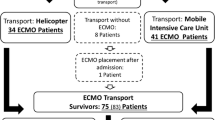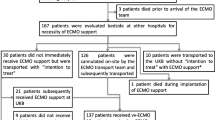Abstract
Purpose
A retrieval program was developed in New South Wales (NSW), Australia to provide extracorporeal membrane oxygenation support (ECMO) for the safe transport of adults with severe, acute respiratory or cardiac failure. We describe the development and results of this program and the impact of the 2009 H1N1 epidemic on this service.
Methods
An observational study of all patients who were retrieved on ECMO support in NSW, from March 1, 2007 to June 1, 2010, was carried out.
Results
Forty adult patients were retrieved on ECMO support (median age 34 years). The indications for retrieval were respiratory in 38 patients (of whom 16 were confirmed or suspected H1N1 cases) and cardiac in 2 patients. Two other patients died after referral but before ECMO support could be established. Patients were transported by road (n = 26, 65%), medical retrieval jet (n = 10, 25%) and helicopter (n = 4, 10%). The median retrieval distance was 250 km (range 12–1,960 km). Thirty-four patients (85%) survived to hospital discharge. Survival for respiratory indications was 87% (33/38 patients) and 50% (1/2 patients) for cardiac indications. There were no deaths or major morbidity associated with these retrievals.
Conclusions
Patients with very severe respiratory failure, which was considered to preclude conventional ventilation for safe transfer to tertiary centres, were managed by an ECMO referral and retrieval program in NSW and had a high rate of survival. This program also enhanced the capacity of the state to respond to a surge in demand for ECMO support due to the H1N1 epidemic, although the role of ECMO in respiratory failure is not yet well defined.


Similar content being viewed by others
References
Murray J, Matthay M, Luce J, Flick M (1998) An expanded definition of the adult respiratory distress syndrome. Am Rev Resp Dis 138:720–723
Vincent JL, Moreno R, Takala J, Willatts S, De Mendonça A, Bruining H, Reinhart CK, Suter PM, Thijs LG (1996) The SOFA (sepsis-related organ failure assessment) score to describe organ dysfunction/failure. Intens Care Med 22:707–710
Bernard GR, Artigas A, Brigham KL, Carlet J, Falke K, Hudson L, Lamy M, LeGall JR, Morris A, Spragg R (1994) Report of the American–European consensus conference on ARDS: definitions, mechanisms, relevant outcomes and clinical trials coordination. Intensive Care Med 20:225–232
Peek GJ, Mugford M, Tiruvoipati R, Wilson A, Allen E, Thalanany MM, Hibbert CL, Truesdale A, Clemens F, Cooper N, Firmin RK, Elbourne D, CESAR trial collaboration (2009) Efficacy and economic assessment of conventional ventilatory support versus extracorporeal membrane oxygenation for severe adult respiratory failure (CESAR): a multicentre randomised controlled trial. Lancet 374:1351–1363
Meade MO, Cook DJ, Guyatt GH, Slutsky AS, Arabi YM, Cooper DJ, Davies AR, Hand LE, Zhou Q, Thabane L, Austin P, Lapinsky S, Baxter A, Russell J, Skrobik Y, Ronco JJ, Stewart TE, Lung Open Ventilation Study Investigators (2008) Ventilation strategies using low tidal volumes, recruitment maneuvers, and high positive end-expired pressure for acute respiratory distress syndrome: a randomized controlled trial. JAMA 299:637–645
Sud S, Friedrich JO, Taccone P, Polli F, Adhikari NK, Latini R, Pesenti A, Guérin C, Mancebo J, Curley MA, Fernandez R, Chan MC, Beuret P, Voggenreiter G, Sud M, Tognoni G, Gattinoni L (2010) Prone ventilation reduces mortality in patients with acute respiratory failure and severe hypoxemia: systematic review and meta-analysis. Intensive Care Med 36:585–599
The Australian New Zealand Extracorporeal Membrane Oxygenation Investigators (2009) Extracorporeal membrane oxygenation for 2009 Influenza A (H1N1) acute respiratory distress syndrome. JAMA 302:1888–1895
Brogan T, Thiagarajam R, Rycus P, Bartlett R, Bratton S (2009) Extracorporeal membrane oxygenation in adults with severe respiratory failure: a multi-center database. Intensive Care Med 35:2105–2114
Mugford M, Elbourne E, Field D (2008) Extracorporeal membrane oxygenation for severe respiratory failure in newborn infants. Cochrane Database of Systemic Reviews, Issue 3. Arl. No: CD001340
Zapol WM, Snider MT, Hill JD, Fallat RJ, Bartlett RH, Edmunds LH, Morris AH, Peirce EC 2nd, Thomas AN, Proctor HJ, Drinker PA, Pratt PC, Bagniewski A, Miller RG Jr (1979) Extracorporeal membrane oxygenation in severe acute respiratory failure. A randomised, prospective study. JAMA 242:2193–2196
Morris AH, Wallace CJ, Menlove RL, Clemmer TP, Orme JF Jr, Weaver LK, Dean NC, Thomas F, East TD, Pace NL, Suchyta MR, Beck E, Bombino M, Sittig DF, Böhm S, Hoffmann B, Becks H, Butler S, Pearl J, Rasmusson B (1994) Randomised clinical trial of pressure-controlled inverse ratio ventilation and extracorporeal CO2 removal for adult respiratory distress syndrome. Am J Respir Crit Care Med 149:295–305
Thiara AP, Hoel TN, Kristiansen F, Karlsen HM, Fiane AE, Svennevig JL (2007) Evaluation of oxygenators and centrifugal pumps for long-term pediatric extracorporeal membrane oxygenation. Perfusion 22:323–326
Khoshbin E, Roberts N, Harvey C, Machin D, Killer H, Peek GJ, Sosnowski AW, Firmin RK (2005) Poly-methyl pentene oxygenators have improved gas exchange capability and reduced transfusion requirements in adult extracorporeal membrane oxygenation. ASAIO J 51:281–287
Bennett M, Horton S, Thuys C, Augustin S, Rosenberg M, Brizard C (2004) Pump-induced haemolysis: a comparison of short-term ventricular assist devices. Perfusion 19:107–111
Lawson DS, Ing R, Cheifetz IM, Walczak R, Craig D, Schulman S, Kern F, Shearer IR, Lodge A, Jaggers J (2005) Hemolytic characteristic of three commercially available centrifugal blood pumps. Pediatr Crit Care Med 6:573–577
Moen O, Høgåsen K, Fosse E, Dregelid E, Brockmeier V, Venge P, Harboe M, Mollnes TE (1997) Attenuation of changes in leukocyte surface markers and complement activation with heparin-coated bypass. Ann Thorac Surg 63:105–111
Fosse E, Moen O, Johnson E, Semb G, Brockmeier V, Mollnes TE, Fagerhol MK, Venge P (1994) Reduced complement and granulocyte activation with heparin-coated cardiopulmonary bypass. Ann Thorac Surg 58:472–477
Beiderlinden M, Eikermann M, Boes T, Breitfeld C, Peters J (2006) Treatment of severe acute respiratory distress syndrome: role of extracorporeal gas exchange. Intensive Care Med 32:1627–1631
Lewandowski K, Rossaint R, Pappert D, Gerlach H, Slama KJ, Weidemann H, Frey DJ, Hoffmann O, Keske U, Falke KJ (1997) High survival in 122 ARDS patients managed according to a clinical algorithm including extracorporeal membrane oxygenation. Intensive Care Med 23:819–835
Boedy R, Howell C, Kanto W (1990) Hidden mortality rate associated with extracorporeal membrane oxygenation. J Pediatr 117:462–464
Breton L, Minaret G, Aboab J, Richard J (2002) Fractional inspired oxygen on transport ventilators: an important determinant of volume delivery during assist control ventilation with high resistive load. Intensive Care Med 28:1181
Zanetta G, Robert D, Guerin C (2002) Evaluation of ventilators used during transport of ICU patients: a bench study. Intensive Care Med 28:441–443
Kjaergaard B, Christensen T, Neumann P, Nurnberg B (2007) Aero-medical evacuation with interventional lung assist in lung failure patients. Resuscitation 72:280–285
Foley DS, Pranikoff T, Younger JG, Swaniker F, Hemmila MR, Remenapp RA, Copenhaver W, Landis D, Hirschl RB, Bartlett RH (2002) A review of 100 patients transported on esxtracorporeal life support. ASAIO J 48:612–619
Coppola C, Turee M, Larry B, DiGeronimo R (2008) A 22-year experience in global transport extracorporeal membrane oxygenation. J Paed Surg 43:4–52
Wilson B, Heiman H, Butler T, Negaard K, DiGeronimo R (2002) A 16 year neonatal/paediatric extracorporeal membrane oxygenation transport experience. Pediatrics 109:189–193
Wagner K, Sangolt GK, Risnes I, Karlsen HM, Nilsen JE, Strand T, Stenseth LB, Svennevig JL (2008) Transportation of critically ill patients on extracorporeal membrane oxygenation. Perfusion 23:101–106
Author information
Authors and Affiliations
Corresponding author
Rights and permissions
About this article
Cite this article
Forrest, P., Ratchford, J., Burns, B. et al. Retrieval of critically ill adults using extracorporeal membrane oxygenation: an Australian experience. Intensive Care Med 37, 824–830 (2011). https://doi.org/10.1007/s00134-011-2158-8
Received:
Accepted:
Published:
Issue Date:
DOI: https://doi.org/10.1007/s00134-011-2158-8




